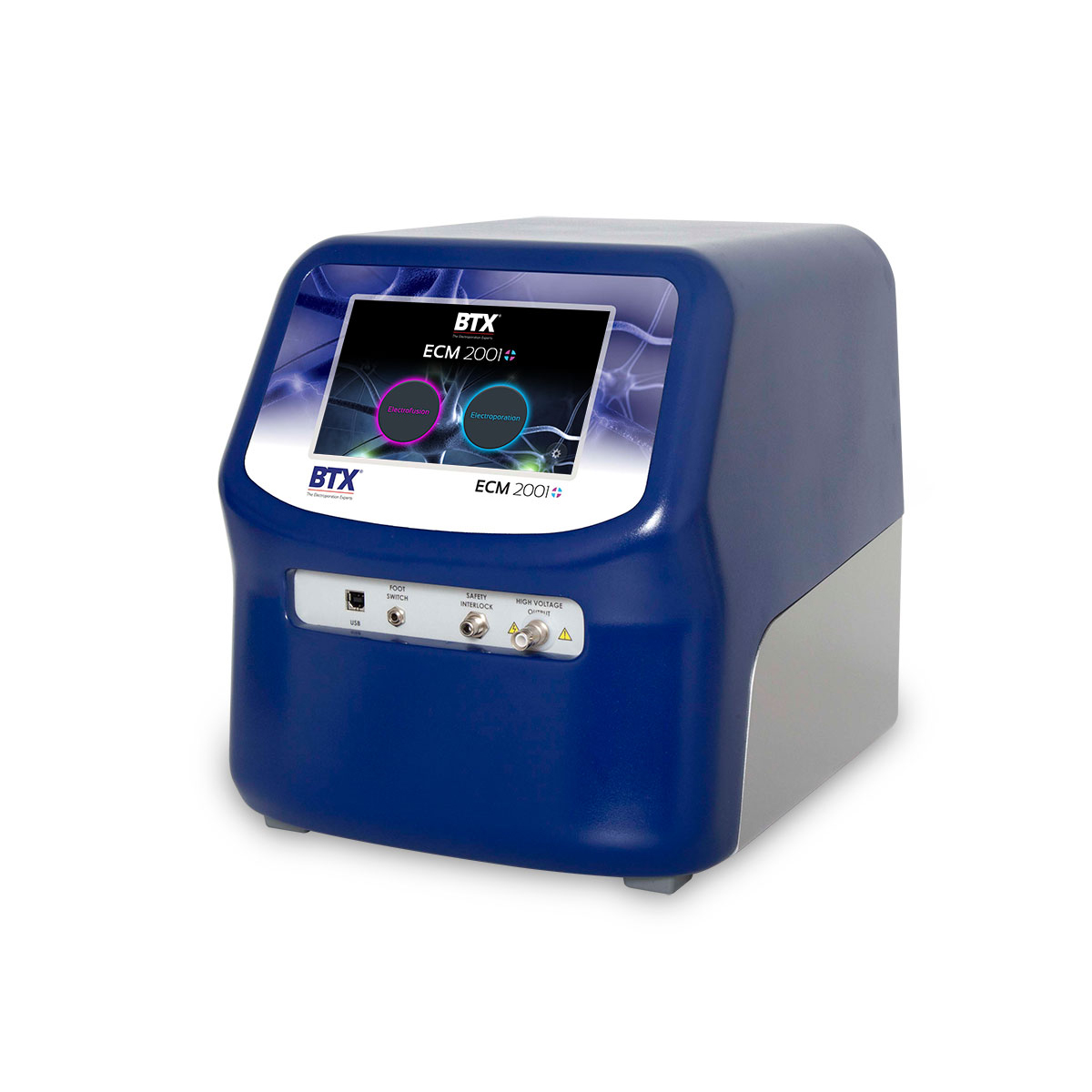Details
Genepaddles electrodes are paddle-style reusable electrodes suitable for a variety of applications. Genepaddles come in two sizes, each size consisting of a pair of electrodes. The Genepaddles feature either rectangular 3 x 5 mm paddles or 5 x 7 mm paddles. These two sizes are designed to target various electroporation areas.
These electrodes are connected to either micrograbber connection cables or square post adaptors and connection cables which interface with our ECM 830, ECM 2001+, ECM 2001, or Gemini X2 pulse generators. The Genepaddles are positioned in parallel at a predetermined gap within a tissue using the Genetrode Holder.
Genepaddles may be cleaned with a mild detergent and sterilized with 70% ethanol or ethylene oxide. Properly maintained Genepaddles have a life span of approximately 200+ pulses, and are compatible with most BTX Electroporation Systems.
APPLICATIONS
In Vitro Embryo Gene Delivery
Genepaddles were designed for in vivo applications and In Vitro Embryo Gene Delivery (IVEGD) in mouse embryo. The electrodes are placed anterior and posterior to the embryo following injection of the molecule of interest, and an electroporation pulse is delivered using a BTX Electroporation System, such as the ECM 830 and ECM 2001+. The electric field introduced by the Genepaddles causes transient pores to form in the cells of tissue, allowing uptake and expression of gene in muscle tissue to target the function of these genes on muscle regeneration Toschi1. The 3 x 5 mm Genepaddle-style electrode were used with a BTX square wave pulse generator to deliver DNA to chick brain slice tissue to study glial cell migration and neurogenesis King3. The success of this method demonstrates the potential of electroporation to transfect different types of tissues or embryos besides the classical avian embryo.
In Vivo Gene Delivery
The use of these paddle-style electrodes for in vivo applications targeting a variety of tissues including muscle and brain tissues. The over expression of Hsp70 protein in mouse skeletal muscle by transfection was found to play a role in the regulation of vasopressin and TNF during muscle regeneration Moresi2. Paddle-style electrodes have also been used for in vivo applications. Miyasaka6 used an electrode to deliver DNA in vivo into the cerebral cortical anlage of E15 rat embryos. He demonstrated high-efficiency gene transfer into intact neural tissue using electroporation. Electroporation has the benefits of being less labor-intensive and more economical than competitive methods for in vivo gene transfer, such as viral methods and ballistics. Electroporation also produces greater viability and efficiency than competitive methods for in vivo gene transfer.
REQUIRED CABLES
| Required for connection to Gemini X2 and ECM 830 | |
| 45-0216 | Micrograbber to Banana Plug Connection Cables, 10 ft |
| Required for connection to ECM 2001+ | |
| 45-0087 | Micrograbber to Banana Plug Adapter Set |
| 45-2057 or 45-2058 | ECM 2001+ HV Output Cable, 5 ft or 10 ft length |
| Required for connection to Legacy ECM 2001 | |
| 45-0216 | Micrograbber to Banana Plug Connection Cables, 10 ft |
| 45-0088 | Female/Female Adapter Set for Banana Plug Cables |
| 45-0083 | Coaxial to Banana Plug Cables, Red and Black, 10 ft |
USE OF GENEPADDLES WITH THE GEMINI X2 AND ECM 830 ELECTROPORATION SYSTEMS
In this example, the Gemini X2 generator is connected using the sequence of cables and adapters illustrated below, then connected to Genepaddles Electrodes.
 |
+ |  |
|
| Gemini X2 System | 45-0216 Micrograbber Cables + Genepaddles Electrodes |
USE OF GENEPADDLES WITH THE ECM 2001+ ELECTROFUSION & ELECTROPORATION SYSTEM
In this example, the ECM 2001+ generator is connected using the sequence of cables and adapters illustrated below, then connected to the Genepaddles Electrodes.
 |
+ |  |
+ |  |
| ECM 2001+ System | 45-0087 Micrograbber Adapters + Genepaddles Electrodes |
USE OF GENEPADDLES WITH THE LEGACY ECM 2001 ELECTRO CELL FUSION & ELECTROPORATION SYSTEM
In this example, the Legacy ECM 2001 generator is connected to the Genepaddles Electrodes using the sequence of cables and adapters illustrated below.
 |
+ |  |
+ |  |
+ |  |
| Legacy ECM 2001 System | 45-0083 Coaxial Cables | 45-0088 Female/Female Adapters | 45-0216 Micrograbber Cables + Genepaddles Electrodes |
STANDARD CAPABILITIES
| Generator Compatibility | ECM 830, ECM 2001+, Legacy ECM 2001, and Gemini X2 |
| Voltage Range | 0 to 200 VDC |
| Pulse Length Range | 1 µs to 99 ms |
| Pulse Number Range | 1 to 99 ms (depending on voltage and pulse length settings) |
| Total number of pulses | Approximately 200 pulses per set of electrodes |
PHYSICAL CHARACTERISTICS
| Item # | 45-0122 | 45-0123 |
| Paddle Dimensions | 3 x 5 mm | 5 x 7 mm |
| Paddle Configuration | Rectangular | Rectangular |
| Paddle Thickness | 1 mm | 1 mm |
All Genepaddle electrodes are gold-plated, non-invasive electrodes
| Genetrode Holder Inter-electrode Gaps | 1 to 10 mm |
- In vivo gene delivery
- In vitro embryo gene delivery
REFERENCES
1. Toschi et al. Skeletal Muscle Regeneration in mice is stimulated by local overexpression of Via-Vasopressin receptor. Molecular Endocrinology. Aug 2011, 2011-1049.
2. Moresi et al. Modulation of caspase activity regulates skeletal muscle regeneration and function in response to vasopressin and tumor necrosis factor. PLoS ONE. 4(5):e5570.doi 10.137/journal .pone May 2009.
3. King et al. Glial migratory streams in the developing hindbrain: A slice culture approach. J. Neuroscience Methods. Feb 2009 177(1); 30-43.
4. Schwarzkopf et al. Muscle cachexia is regulated by a p53-PW1/Peg3-dependent pathway. Genes and Development. 20:3440-3452 2006.
5. Itasaki et al. 'Shocking' developments in chick embryology: electroporation and in ovo gene expression. Nature Cell Biology. 1: E203-E207. (1999) BTX Reference ID#4699
6. Miyasaka et al. Foreign gene expression in an organotypic culture of cortical anlage after in vivo electroporation. NeuroReport. 10: 2319-2323. (1999). BTX Reference ID#4641



 800-272-2775
800-272-2775
